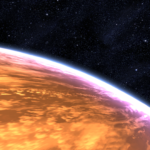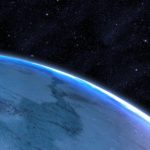System Specs:
- Stellar Mass: N/A Sol Masses
- Stellar Class: N/A
- Luminosity: N/A Sol
- Planets: 6
- Moons: 0
- Asteroid Belts: 0
- Asteroids: 0
- Objects: 1

Antaeus is a system composed of four terrestrial worlds and two gas giants. None of the terrestrial planets are livable, although Trebin is undergoing some terraforming efforts. Should those efforts be successful, a helium-3 refining facility is expected to be built on Edmos. The worlds have potential in untapped resources, although exploitation is discouraged for the time being due to rough terrain and hostile environments.
“This mission just got a lot more complicated.” — Spoilers for Mass Effect follow. SmallMLogo.png
The system has a few mysteries to ponder on. On Trebin is a buried Reaper artifact that transformed the survey team that discovered it into husks. Massive structures have been detected on the gas giant Ploba, although the exact nature of these objects is yet undetermined.
–
Planets Directory:
- Ageko
- Edmos
- Ploba
- Trebin
- Vemal
- Hunidor
- Mass Relay
–
Ageko:

- Orbital Distance: 0.25 AU
- Orbital Period: 0.1 Earth-years
- Keplerian Ratio: 1.563
- Radius: 2,147 km
- Day Length: 59.9 Earth-hours
- Atmospheric Pressure: 0.27 atm
- Surface Temp: 346 °C
- Surface Gravity: 0.25 g
- Mass: 0.028 Earth-masses
During the initial survey of the Antaeus system, only a single fly-by probe was spared for the small, scorched world of Ageko. It revealed a planet unusually rich in heavier elements, given its size.
Ageko is a standard terrestrial with a thin atmosphere of krypton and xenon. Its crust is mainly composed of magnesium with deposits of cobalt and other heavy metals. Due to extremely rough, cratered terrain, starships are discouraged from landing.
–
Edmos:

- Orbital Distance: 3.65 AU
- Orbital Period: 7.8 Earth-years
- Keplerian Ratio: 0.799
- Radius: 36,826 km
- Day Length: 13.7 Earth-hours
- Atmospheric Pressure: N/A atm
- Surface Temp: N/A °C
- Surface Gravity: N/A g
- Mass: N/A Earth-masses
Edmos is a standard hydrogen-helium gas giant with traces of methane in its atmosphere. If Trebin’s terraforming is successful, it is expected that a helium-3 fuel refining facility for the system will be set up here.
–
Ploba:

- Orbital Distance: 6.93 AU
- Orbital Period: 20.4 Earth-years
- Keplerian Ratio: 0.8
- Radius: 74,221 km
- Day Length: 17.3 Earth-hours
- Atmospheric Pressure: N/A atm
- Surface Temp: N/A °C
- Surface Gravity: N/A g
- Mass: N/A Earth-masses
Ploba is the second, and by far the larger, of Antaeus’ two gas giants. Active scans by survey ships have returned tantalizing indications of massive, solid structures deep within the atmosphere, too regular in pattern to be anything natural.
Some believe Ploba is a “Jupiter Brain,” a planet-sized supercomputer. Adherents of this theory have fruitlessly beamed signals toward the sunken megastructures, hoping to get the machine’s attention.
Others believe that an ancient spacefaring race disposed of their weapons of war by dumping them into the planet. The last attempt to reach and salvage Ploba’s “Deep Anomalies” went tragically wrong, and ended with a crew of 12 being trapped and crushed in the gas giant’s lower atmosphere.
Survey Text
“You discover a strange object orbiting Ploba. Chief Engineer Adams and Tali tried unsuccessfully to determine its origin. They did find one of Matriarch Dilinaga’s writings stored within.”
–
Trebin:
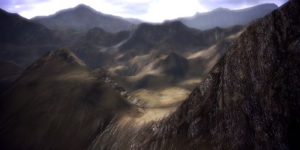
- Orbital Distance: 1.0 AU
- Orbital Period: 1.1 Earth-years
- Keplerian Ratio: 0.826
- Radius: 5,489 km
- Day Length: 41.8 Earth-hours
- Atmospheric Pressure: 0.84 atm
- Surface Temp: 8 °C
- Surface Gravity: 0.86 g
- Mass: 0.632 Earth-masses
- Satellites: 2
Trebin is a modest terrestrial world, with an atmosphere composed of nitrogen and argon. Its surface is mainly composed of nickel with deposits of silver.
Trebin’s environment is relatively mild, but the scarcity of water or similar enabling substances has prevented the development of any biosphere. ExoGeni Corp recently performed a test impact of a single water-ice comet into the surface, the first step of a long-term plan to thicken the atmosphere and introduce water to the environment.
A survey team is on the surface, monitoring the geological and meteorological effects of the test impact. Most of the water released is still in the form of atmospheric vapor, but thick cloud banks have formed. There is every indication that this arid world will soon see its first rain. The survey team’s progress has been hampered by frequent mechanical or computer failures in their GPS satellites.
–
Vemal:
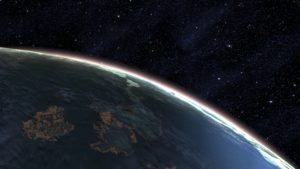
- Orbital Distance: 10.38 AU
- Orbital Period: 37.5 Earth-years
- Keplerian Ratio: 0.795
- Radius: 10,314 km
- Day Length: 36.3 Earth-hours
- Atmospheric Pressure: 1.0 atm
- Surface Temp: −61 °C
- Surface Gravity: 1.1 g
- Mass: 2.855 Earth-masses
Vemal is an enormous terrestrial world of mixed rock and ice with an atmosphere of methane and ethane. Its frozen surface is mainly composed of calcium with deposits of iron. Because of noxious surface gases, explorers are warned to use extreme caution.
–
Hunidor:
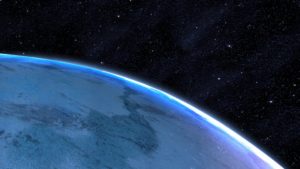
- Orbital Distance: 18.68 AU
- Orbital Period: 90.5 Earth-years
- Keplerian Ratio: 0.796
- Radius: 3,686 km
- Day Length: 48.2 Earth-hours
- Atmospheric Pressure: 0.2 atm
- Surface Temp: −202 °C
- Surface Gravity: 0.22 g
- Mass: 0.073 Earth-masses
Hunidor is a moderately sized ice world with an extremely thin atmosphere composed of krypton and xenon. Its frozen surface is unusually smooth, suggesting widespread “repaving” by cryovolcanic processes though no such activity is currently evident.
–
–
video



